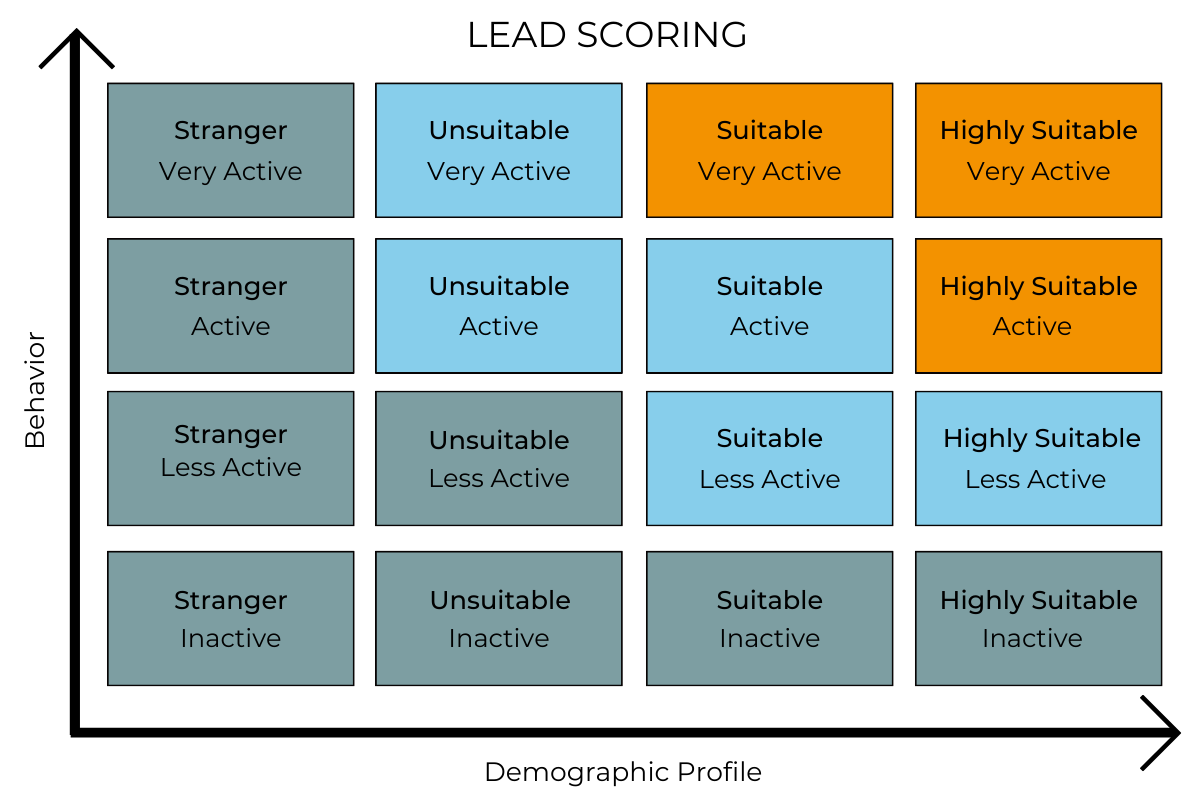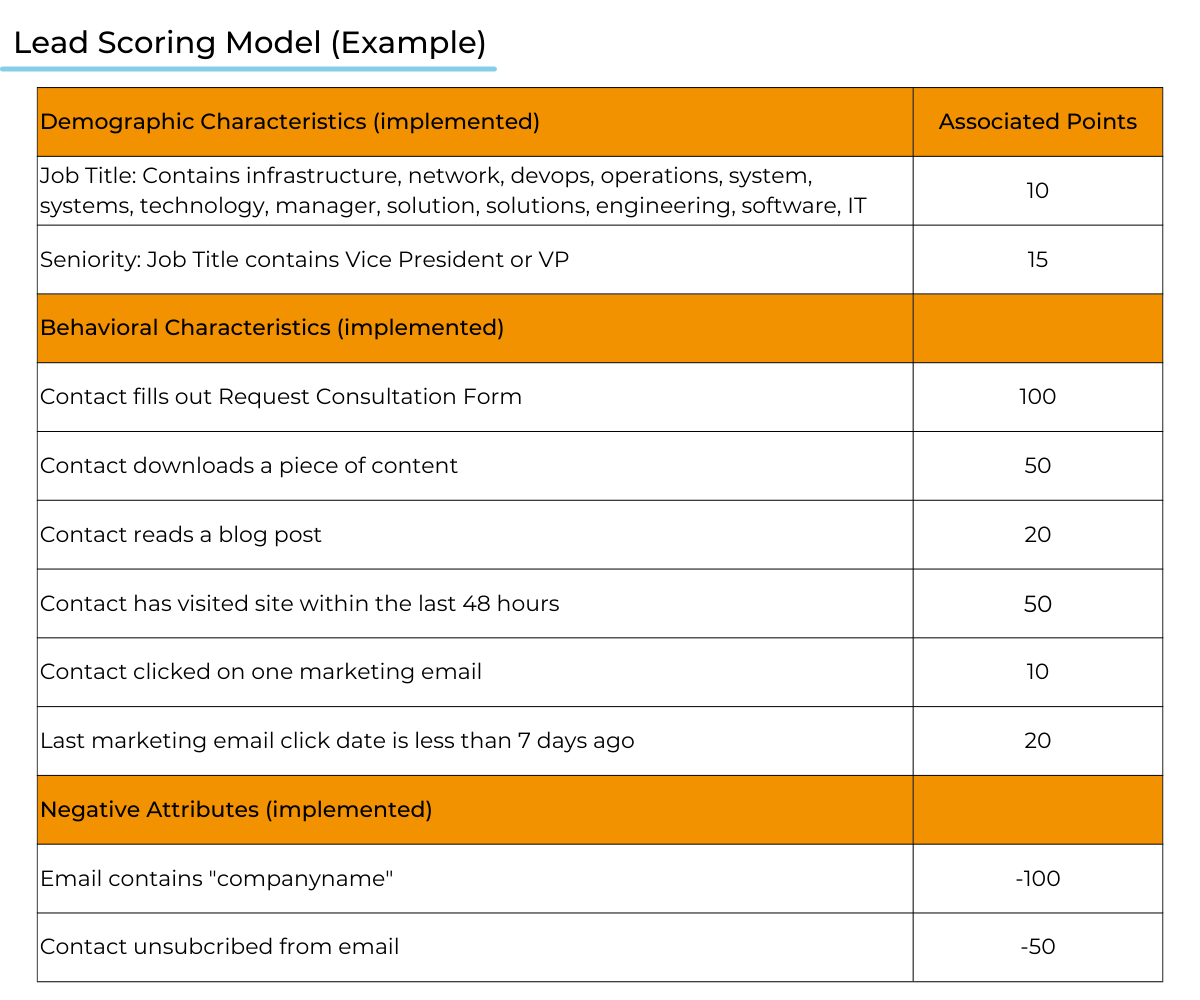
Best Practices to Developing an Effective Lead Scoring Model
Best Practices to Developing an Effective Lead Scoring Model
Garnering a surplus of leads is great. But knowing which leads are most likely to make a purchase is even better. Lead scoring is the process of collecting as much data as possible from leads by assigning points for each behavioral action (like viewing a blog or downloading an ebook) to qualify and prioritize leads.
According to a recent study, B2B organizations who used a lead scoring model increased close rates by 30%, company revenue by 18%, and revenue per deal by 17%. Developing and implementing a lead scoring model is a crucial part of an effective marketing strategy. In this article, we’re getting into every crack and crevice of creating an effective lead scoring model so that you can identify and target the most qualified leads to boost your top line.
Who Benefits From Lead Scoring and Why is a Lead Scoring Model Important?
Both marketing and sales teams benefit from lead scoring. Carefully organizing your marketing leads is essential to provide sales reps with the most relevant leads to close the most deals. Through the process of lead scoring, you’ll be able to easily identify which leads are qualified to speak with sales. This way, your sales team isn’t wasting their time on leads that may not be ready to make a purchasing decision.
Think about the lead scoring process like this:

Essentially, the more data you collect from leads based on their behaviors and demographics tells you whether or not they’re qualified to speak to sales. In the graphic above you’ll notice that as leads engage with your brand through digital channels (your website, emails, and other content) they become highly suitable for sales reps to reach out to them with a personal email. Additionally, depending on the lead’s demographic profile such as their job title, industry, and seniority, they are also ranked on whether or not they’re a qualified lead. Ultimately, the more active a lead is and the better the lead fits your target audience based on demographics, the more qualified they become and the more likely they are to purchase!
Now, let’s look at an example of a lead scoring model based on a 100-point system. Each behavior or demographic characteristic depicted in this model is assigned a certain number of points. As leads trigger each of these behaviors, they will receive a certain number of points in a CRM like HubSpot, for example. Once a lead reaches 100 points or higher, they officially become a marketing qualified lead or MQL.

As shown in the lead scoring model example above, there are also negative attributes that can reduce the number of points assigned to a lead if they, for example, work at your company, unsubscribe from your marketing emails, or if they’re a student.
Pro Tip: Keep in mind that all lead scoring models are personalized to fit the needs of your company, buyer personas, and goals. These models are dynamic and as your goals and priorities change, so can your lead scoring model.
1. Define Your Top Data Points to Strategically Create Your Lead-Nurturing Campaigns
Now that you have a deeper understanding of lead scoring and what a lead scoring model looks like, let’s unveil the best practices for developing an effective lead scoring model. The first step is to identify the key data points that will assign leads points based on:
- Demographic information
- Company information
- Website activity
- Email engagement
As stated previously, each lead scoring model will differ depending on an organization’s target audience and goals. However, no matter the industry you’re in, each data point above is imperative to include in your lead scoring model. For example, consider who your target audience is. Do you want to sell primarily to c-suite executives? If so, you may want to assign a larger number of points to leads with the title “vice presidents” or above.
2. Pinpoint High-Value Website Actions to Identify a Lead’s Area of Interest
Each click, view, and engagement increases the lead’s score and also showcases which topics they’re interested in. It’s important to attribute an adequate amount of points that equals the “weight” of certain behavior.
For instance, if a lead downloads an ebook from your website, they should be assigned approximately 50 points automatically. However, if a lead opens just one marketing email, they should be assigned just 5 points. This is because the value of the lead downloading the ebook is greater than viewing one email. The act of downloading the ebook shows that the lead is highly interested in your product or service. Whereas, opening an email is less of an impactful or telltale sign that the lead is actually interested.
Additionally, when a lead becomes an MQL and is passed along to the sales team, the assigned sales rep can see which actions and pieces of content the lead engaged with. From here, the sales rep can better sell to the prospect with a deeper understanding of the prospect’s pain points, use case, and needs.
3. Avoid Over-Inflated Scores with Negative Attributes
One crucial part of a lead nurturing model is to include negative attributes. A negative attribute is a data point that proves any given lead is not a great fit for your company. For example, if you’re targeting CEOs, having a lead come through that’s a student (denoted by having “.edu” in their email) would be a waste of your sales reps’ time.
Negative attributes prevent poor leads from qualifying. Another example is if a co-worker is engaging with content on your company’s site. Obviously, this person is not a lead and therefore should not become an MQL. The best approach to ensure this person doesn’t reach 100 points to be an MQL is to add the negative attribute that subtracts 100 points from a lead's score if a contact has your company name in their email address.
4. Lower an Inactive Lead’s Score with Point Decay
Point decay is a vital piece of lead scoring models. Point decay is the process of subtracting points from leads that haven’t engaged with your company over a matter of days. Having the insight as to when a contact’s points decay is critical to marketing success. Empowered with this knowledge, you can add these decaying leads into a nurture campaign to activate their account again.
Below are a few examples of point decay options:
- No activity for 7 days: 5 points subtracted
- No activity for 10 days: 10 points subtracted
- No activity for 20 days: 20 points subtracted
- No activity for 1 month: Clear lead score
Essentially, point decay allows you to weed out the inadequate leads from those most likely to convert into customers. This will save your sales reps valuable time they can spend selling to best-fit leads.
5. Continuously Monitor Your Lead Scoring Model to Ensure Effectiveness
Lastly, it’s extremely vital to continuously monitor your lead scoring model. As time goes on and new marketing trends and consumer habits change, your lead scoring model will need to be updated to reflect these changes.
For example, if marketing trends show that video is the most effective piece of content to attract leads, you may want to consider adding in a data point in your lead scoring model that assigns 20 points to a contact record if they watch a video on your site.
Final Thoughts
Developing an effective lead scoring model is crucial to the success of your marketing initiatives, of course. But it’s also vital to your sales success. Keeping marketing and sales departments in alignment via a lead scoring model is one of the most effective ways to drive revenue and boost your top line.
Möve Marketing is proud to be an expert at developing effective lead scoring models and would be more than happy to help your organization score leads in a meaningful way. Get in touch with us to get started.




